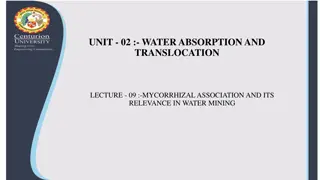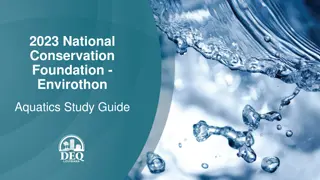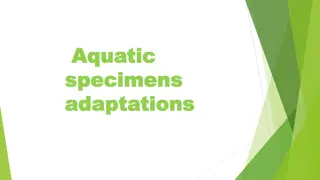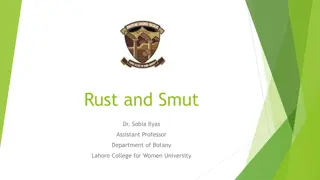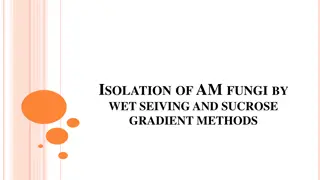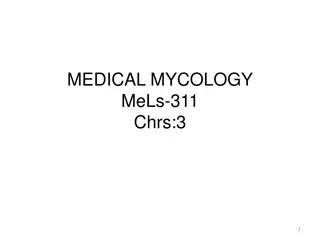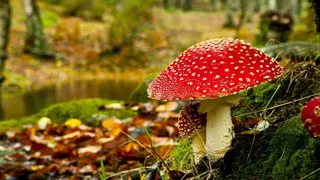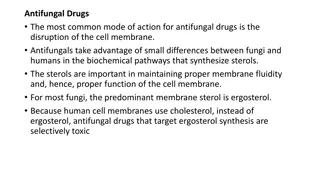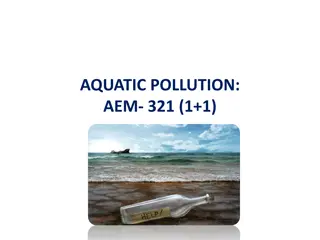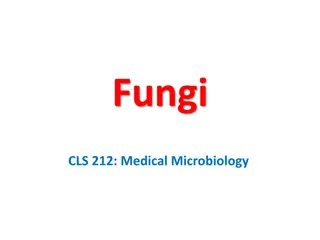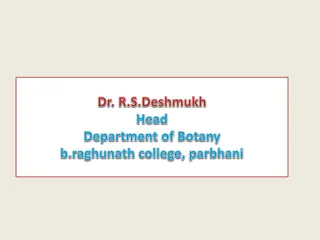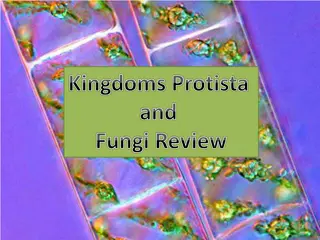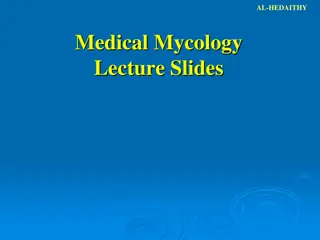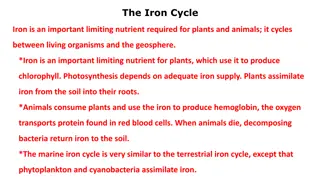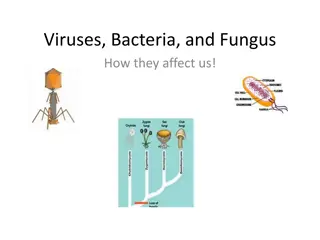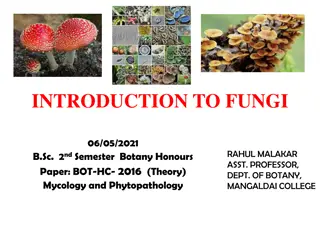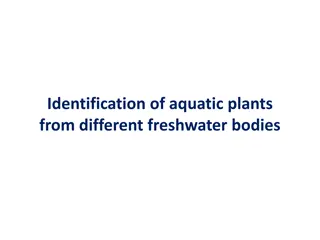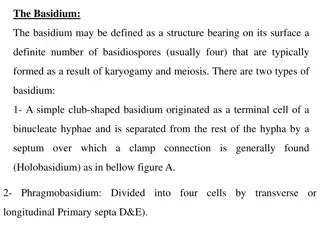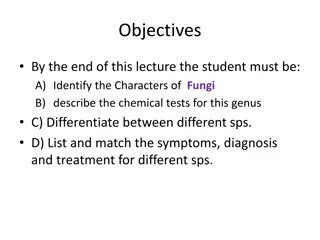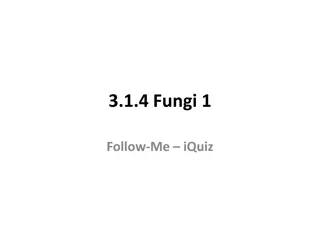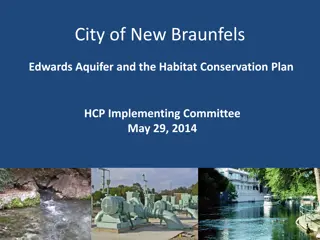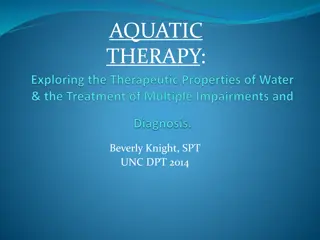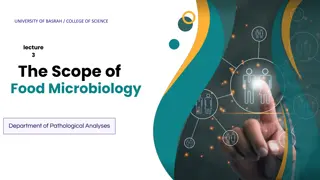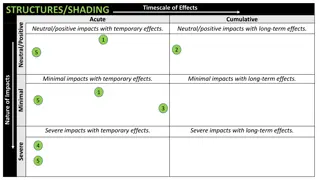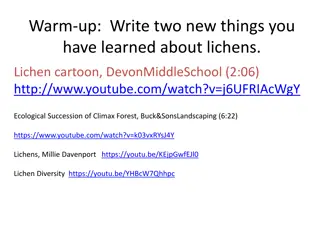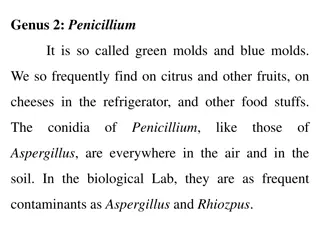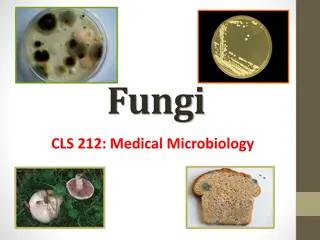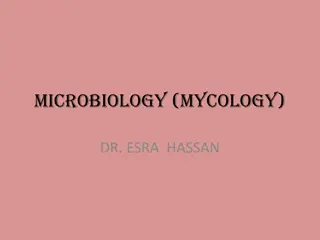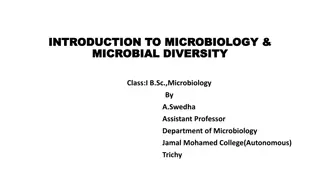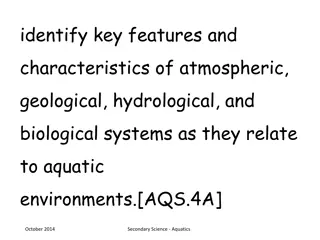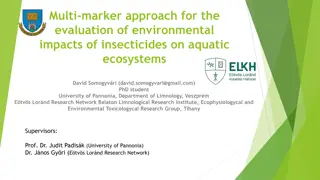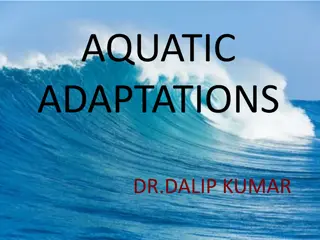Mycorrhizal Association and Its Importance in Water Mining
Mycorrhizal association plays a crucial role in facilitating nutrient and water absorption for plants through a symbiotic relationship with fungi. This relationship enhances the plant's ability to acquire minerals from the soil while providing essential compounds to the fungi. The mycorrhizal associ
3 views • 6 slides
2023 National Conservation Foundation - Envirothon
Explore the intricate dynamics of aquatic ecosystems and wetlands conservation through this comprehensive study guide. Discover the importance of watersheds, the hydrologic cycle, aquatic food webs, energy flow at trophic levels, and common macroinvertebrates in Louisiana. Learn about different wetl
3 views • 27 slides
Adaptations of Aquatic Specimens, with a Focus on Sea Snakes
Aquatic specimens, particularly sea snakes of the subfamily Hydrophiinae, exhibit fascinating adaptations for their fully aquatic lifestyle. These marine snakes are uniquely adapted for life in the sea, with specialized features such as paddle-like tails, compressed bodies, and the ability to respir
0 views • 16 slides
Understanding Rust and Smut Fungi in Basidiomycotina
Basidiomycotina is a diverse group of fungi encompassing classes like Teliomycetes and Hymenomycetes. Rust and smut fungi belong to the class Teliomycetes, characterized by dikaryotic resting spores and unique modes of reproduction. Within the Teliomycetes, the order Uredinales, known as rust fungi,
0 views • 21 slides
Isolation of AM Fungi by Wet Sieving and Sucrose Gradient Methods
Wet sieving is a popular technique to isolate different sizes of spores from soil samples. Developed by Gerdemann and Nicolson in 1963, this method involves passing an aqueous suspension through different sieves to collect spores of varying sizes. The process includes agitating the soil-water mixtur
0 views • 14 slides
An Overview of Medical Mycology: Fungi and Their Characteristics
Medical mycology, focusing on fungi that infect humans, explores the study of fungi, their morphology, classification, and diseases. Fungi, non-photosynthetic organisms, lack chlorophyll and depend on external organic sources for nutrients. With an eukaryotic nature, fungi exhibit less differentiati
0 views • 68 slides
Understanding Fungi Diversity and Infections in Microbiology
Explore the world of fungi and fungal infections in this foundation block of microbiology. Learn about medically important yeasts, mold fungi, major fungal diseases, antifungal agents, and infection acquisition methods. Dive into hypersensitivity reactions, mycotoxicoses, and various types of fungal
1 views • 19 slides
Understanding Mycorrhiza: Types, Importance, and Classification
Mycorrhiza is a symbiotic association between fungi and plant roots crucial for plant survival. Around 95% of plant species form mycorrhizal relationships, with mycorrhizae existing since the earliest land plants. Classification includes Ectomycorrhiza and Endomycorrhiza based on tropic levels. Ecto
0 views • 21 slides
Understanding Antifungal Drugs: Modes of Action and Applications
Antifungal drugs target ergosterol biosynthesis in fungi, disrupting cell membrane integrity. Imidazoles like miconazole and ketoconazole are commonly used for skin infections, while triazoles such as fluconazole treat systemic yeast infections. Allylamines inhibit ergosterol synthesis, with terbina
0 views • 13 slides
Understanding Aquatic Adaptation in Animals
Aquatic adaptation refers to the changes in an animal's body organization to thrive in a water habitat. Vertebrates have evolved to lead partial or total aquatic lives, showcasing various adaptations. Water as a habitat offers a homogenous medium, stable conditions, and rich food resources. Aquatic
0 views • 9 slides
Understanding Chytridiomycota: The Flagellated Fungi
Chytridiomycota is a phylum of fungi distinguished by having motile spores with a single posterior flagellum. They are primarily aquatic, parasitic on algae and animals, and play a role in plant diseases. Their unique characteristics include alternation of generation and somatic phase with rhizoids.
8 views • 11 slides
Understanding Aquatic Pollution and Its Impact on Water Quality
Aquatic pollution is a significant concern affecting the environment and human health. It includes various pollutants entering water bodies from land-based activities, causing harm to aquatic life and humans. Pollution sources can be classified into point source and non-point source. Monitoring wate
2 views • 13 slides
General Characteristics of Phycomycetes in Fungi Classes
Fungi are classified into four classes based on hyphae, spores, and reproduction methods. Phycomycetes, as an algal-like fungi class, showcase varied forms with reproduction mainly through sexual or asexual means. The thallus structure varies from one-celled to well-branched mycelium, and reproducti
0 views • 22 slides
Understanding the Fascinating World of Fungi: Mycology Insights
Explore the realm of fungi through the lens of mycology, delving into their diverse characteristics, including their eukaryotic nature, heterotrophic lifestyle, and impact on various ecosystems. Discover how fungi play crucial roles as saprophytic, symbiotic, or parasitic organisms, influencing food
0 views • 26 slides
Aquatic Treatment Systems for Wastewater Reclamation and Reuse
In aquatic systems, wastewater treatment involves bacterial metabolism and sedimentation, with aquatic plants playing a role in improving treatment capabilities. This article discusses the functions of aquatic plants in treatment systems and the categories of wetlands used for wastewater treatment,
1 views • 15 slides
Introduction to Lichens: General Overview, Classification, and Economic Importance
Lichens are symbiotic organisms composed of fungi and algae, with the algal component synthesizing food while the fungal component provides structure. They have unique characteristics and are classified based on their fungal partner, thallus forms, and habitat. Ascolichens and Basidiolichens are two
0 views • 24 slides
Exploring Kingdoms Protista and Fungi: Characteristics and Structures
Dive into the world of Protista and Fungi through this interactive review. Discover the unique characteristics of protists, identify different types of protists, and learn about essential structures in protists such as contractile vacuoles. Explore the significance of compounds like fucoxanthin in b
0 views • 27 slides
Comprehensive Overview of Medical Mycology and Fungal Structures
Explore the field of medical mycology through lecture slides by AL-HEDAITHY covering various topics such as basic mycology, superficial mycoses, primary systemic mycoses, fungal structures, and reproduction in fungi. Dive into details about different fungal infections, their characteristics, forms o
0 views • 94 slides
The Iron Cycle and Aquatic Microbiology
Iron plays a crucial role in terrestrial and marine ecosystems, cycling between living organisms and the geosphere. It is a vital nutrient for plants, essential for chlorophyll production, and for animals, needed to create hemoglobin. The marine iron cycle involves phytoplankton and cyanobacteria as
0 views • 19 slides
Understanding How Viruses, Bacteria, and Fungi Impact Human Health
Explore the intricate world of viruses, bacteria, and fungi and how they interact with living organisms. Learn about the structure and functions of viruses, the role of bacteria in diseases, and the implications of fungi on human health. Discover the different ways these microorganisms affect us and
0 views • 37 slides
General Characteristics of Fungi and Mycology Overview
Fungi, diverse eukaryotic organisms, exhibit various characteristics such as heterotrophic nature, distinct cell wall composition, and different modes of reproduction. Mycology, the study of fungi, delves into their classification and functions. Fungal cells may be unicellular or filamentous, with m
0 views • 15 slides
Understanding Thermal Pollution and Its Sources
Thermal pollution is the detrimental effect of heated effluents discharged by power plants on aquatic and terrestrial ecosystems. This pollution occurs when the temperature of water bodies rises significantly due to human activities, leading to a reduction in dissolved oxygen and impacting aquatic l
0 views • 19 slides
Identification of Aquatic Plants in Freshwater Bodies Based on Habitat Classification
Before identifying aquatic plants in freshwater bodies, it's vital to classify them into floating macrophytes, marginal macrophytes, submerged macrophytes, and emergent macrophytes. This classification aids in distinguishing various plant species such as Eichhornia, Salvinia, Pistia, Lemna, and Azol
0 views • 9 slides
Understanding Basidium: Structure and Classification of Basidiomycetes
The basidium is a key structure in fungi bearing basidiospores formed through karyogamy and meiosis. Basidiomycetes are classified into sub classes based on basidium types such as Heterobasidiomycetidae and Homobasidiomycetidae. Uredinales and Ustilaginales are orders of basidiomycetes involving rus
0 views • 6 slides
Overview of Marine Fungi and Their Habitats
Marine fungi are diverse species that inhabit marine environments, with some being obligate marine fungi while others can adapt to various habitats. They play essential roles in marine ecosystems by decomposing organic matter and interacting with other organisms. Factors affecting their distribution
2 views • 13 slides
Understanding Fungi: Characteristics and Types in Medical Mycology
Explore the world of fungi in medical mycology, including their characteristics, chemical tests, species differentiation, symptoms, diagnosis, and treatment. Learn about dermatophytosis, dermatomycosis, actinomyces, and the differences between fungi and bacteria. Discover the various types of fungi,
0 views • 68 slides
Understanding Yeasts and Rhizopus in the Fungi Kingdom
Explore the characteristics of yeasts and Rhizopus within the Fungi kingdom through a series of quiz questions. Learn about their habitats, modes of reproduction, and unique features that distinguish them as fungi. Test your knowledge and delve into the fascinating world of these microorganisms.
0 views • 50 slides
Conservation Plan for Aquatic Habitat Restoration in New Braunfels
This plan outlines various projects aimed at managing aquatic habitats in New Braunfels for the restoration and preservation of native species such as the fountain darter. It includes objectives like flow manipulation, non-native vegetation control, and restoration of aquatic vegetation in the Comal
0 views • 17 slides
Exploring Aquatic Therapy: Benefits, Techniques, and Research Findings
Aquatic therapy, presented by Beverly Knight, SPT, offers a unique approach to rehabilitation with properties of water like buoyancy and resistance. This therapy can benefit patients with various conditions such as chronic pain, arthritis, and neurological impairments. The content covers indications
0 views • 22 slides
Insights into Airborne Microorganisms and Fungi: Implications for Food Safety
Airborne microorganisms and fungi play crucial roles in food microbiology, with various species surviving in the atmosphere despite hostile conditions. Bacteria like Bacillus and Streptomyces disperse through air turbulence, while fungi such as Penicillium and Aspergillus produce spores resistant to
0 views • 9 slides
Marine Aquaculture Impacts on Submersed Aquatic Vegetation
The document explores the impacts of structures and shading used in commercial shellfish mariculture activities on submersed aquatic vegetation, particularly seagrasses. It discusses the varying effects of mariculture structures on eelgrass density, productivity, and the potential habitat they provi
0 views • 11 slides
Understanding Food Webs in Aquatic Habitats
Exploring the intricate relationships within aquatic food webs, this content delves into the control of beneficial and pest species, highlighting the importance of biodiversity and the factors that influence species presence and success. From the role of frogs in the ecosystem to the impact on tadpo
1 views • 6 slides
Fascinating Insights into Lichens: Algae, Fungi, and Ecological Succession
In the world of lichens, a unique symbiotic relationship between algae and fungi thrives, showcasing the wonders of mutualism. Through photosynthesis, algae produce glucose and oxygen, while fungi provide stability and protection on rocks. This partnership plays a crucial role in primary succession,
0 views • 4 slides
Insights into Penicillium and Gymnoascaceae Fungi
Penicillium fungi, known as green molds and blue molds, are commonly found on citrus fruits, cheeses, and other food items. Various Penicillium species can cause fruit decay and are used in antibiotic production. Gymnoascaceae fungi include dermatophytes and systemic pathogens for humans. Nannizzia
0 views • 6 slides
Understanding the Fascinating World of Fungi in Medical Microbiology
Fungi are eukaryotic organisms with diverse characteristics and roles in nature. They are essential for the ecosystem, being heterotrophic and distinct from plants. In medical microbiology, fungi play crucial roles, such as in the production of antibiotics and foods like cheese. The classification,
0 views • 34 slides
Understanding Fungi: A Brief Overview of Mycology in Microbiology by Dr. Esra Hassan
Fungi, classified as living eukaryotic microorganisms, exhibit diverse structural forms such as yeasts and molds in mycology. This field explores the characteristics, pathogenicity, and importance of fungi, particularly Candida in oral mycology. Discover the fundamental concepts of morphology, hypha
0 views • 32 slides
Exploring Microbial Diversity: Fungi in Microbiology
Microbes are vital single-celled organisms that exist everywhere, some beneficial while others harmful. Fungi, a crucial group of microbes, can be unicellular or multicellular, with diverse roles in nature and human activities. This article delves into the characteristics and classification of fungi
0 views • 15 slides
Understanding Aquatic Environments: Systems and Interactions
Explore the key features and characteristics of atmospheric, geological, hydrological, and biological systems in relation to aquatic environments. Apply systems thinking to analyze positive and negative feedback cycles. Utilize technology to collect and evaluate global environmental data. Evaluate d
0 views • 28 slides
Multi-Marker Approach for Evaluating Environmental Impacts of Neonicotinoids on Aquatic Ecosystems
Neonicotinoids, a class of insecticides, are widely used in agriculture but pose environmental risks to aquatic organisms. This study by David Somogyvári explores the effects of neonicotinoids on aquatic ecosystems using a multi-marker approach, focusing on the toxicity levels and potential impacts
0 views • 18 slides
Aquatic Adaptations in Marine Life
This informative content discusses the primary and secondary aquatic adaptations in marine animals such as fish, whales, turtles, and ducks. It covers various adaptations like streamlined bodies, presence of swim bladders, flippers for navigation, and webbed feet for swimming. Each adaptation is vit
1 views • 14 slides
